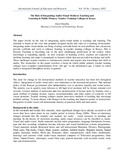| dc.contributor.author | Omariba, Alice | |
| dc.date.accessioned | 2022-02-18T13:48:28Z | |
| dc.date.available | 2022-02-18T13:48:28Z | |
| dc.date.issued | 2022 | |
| dc.identifier.issn | 2411-5681 | |
| dc.identifier.uri | http://hdl.handle.net/123456789/5515 | |
| dc.description.abstract | The paper dwells on the role of integrating audio-visual media to teaching and learning. The
rationale is based on the view that properly designed media add value to a teaching environment.
Integrating audio-visual media can bring exciting curricula based on real-problems into classroom;
provide scaffolds and tools to enhance learning in teacher training colleges in Kenya. This is
because Teaching is becoming one of the most challenging professions in the society where
knowledge is expanding rapidly. As new concepts of learning evolve, teachers are expected to
facilitate learning and make it meaningful to learners rather than just provide knowledge and skills.
These challenges require teachers to continuously retrain and acquire new knowledge and skills in
media. The researchers in this paper envision a future in which public primary teacher training
colleges have complete transformation from “old age” to the information age, a future in which
media is integrated throughout society in general. | en_US |
| dc.language.iso | en | en_US |
| dc.publisher | International Journal of Education and Research Vol. 10 No. 1 January 2022 | en_US |
| dc.subject | audio-visual media, teaching, learning | en_US |
| dc.title | The Role of Integrating Audio-Visual Media to Teaching and Learning in Public Primary Teacher Training Colleges in Kenya | en_US |
| dc.type | Article | en_US |

